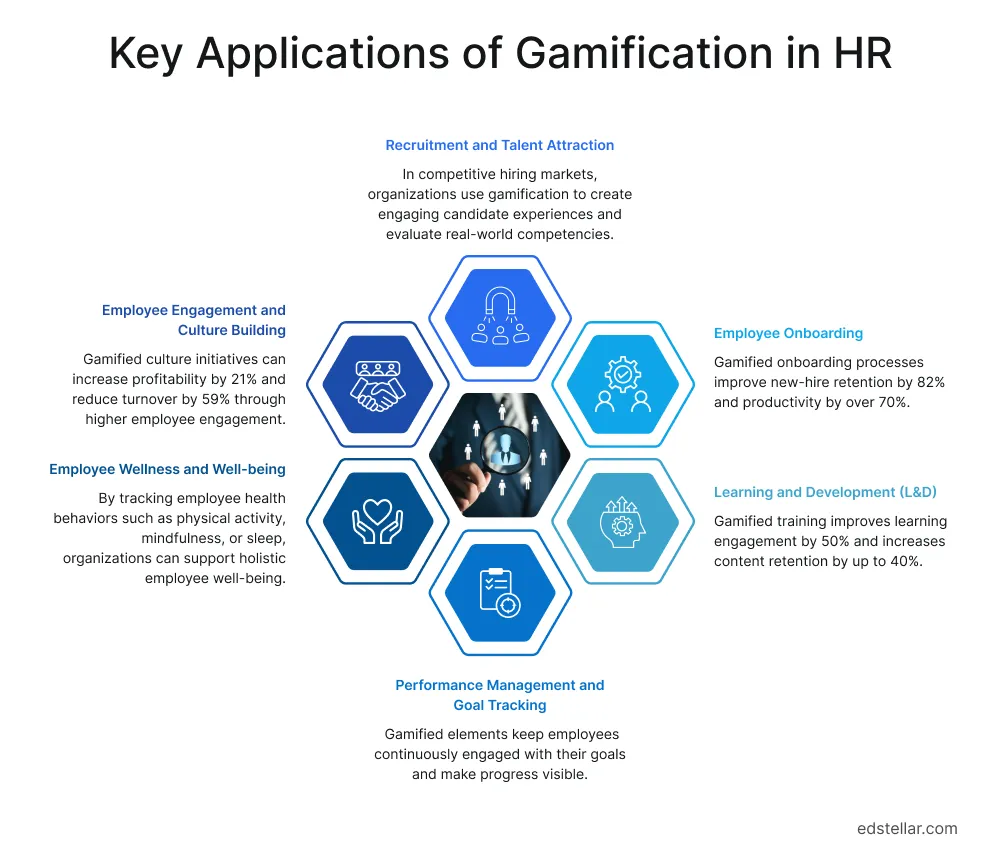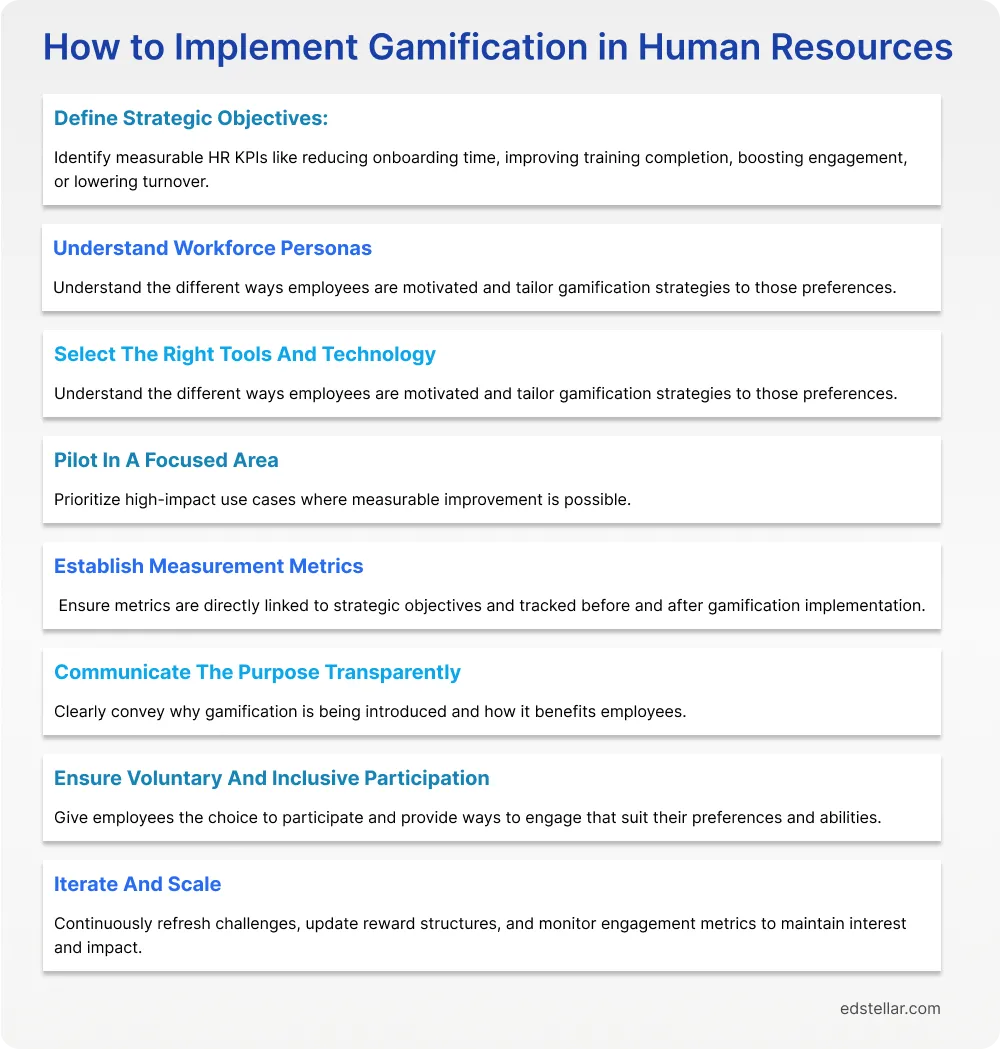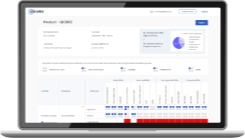
In today’s talent marketplace, the most successful organizations don’t treat workforce engagement as a side initiative, they measure it as a primary driver of growth. According to McKinsey’s State of Organizations 2023 report, 60 % of global executives say that building workforce engagement and adaptability is their top priority, yet most acknowledge their current strategies are falling short. As digital acceleration meets talent shortages, HR leaders face a fundamental question: How do we keep people motivated, continually learning, and aligned in an environment of perpetual change?
Traditional engagement tools like compliance training, annual reviews, and top-down feedback cycles are no longer enough. Hybrid work, project-based roles, and AI-driven workflows demand fresh, immersive HR strategies that embed motivation and learning directly into the workflow.
A February 2025 study titled Gamification in HR Management: Increasing Employee Motivation and Competence Through an Interactive Approach analyzed case studies and found that integrating game elements such as points, badges, leaderboards, and team-based challenges can significantly enhance motivation, competence, productivity, job satisfaction, and overall engagement.
A Deloitte Human Capital Trends report reinforces this insight, noting that organizations that prioritize employee experience through personalization and digital enablement outperform peers in profitability, talent retention, and resilience.
What Is Gamification in HR?
Gamification in HR refers to the strategic application of game-design elements such as points, badges, levels, leaderboards, and challenges within HR processes to enhance engagement, motivation, and performance. Though it may sound playful, this approach is rooted in behavioral science, transforming passive HR tasks into dynamic, participatory experiences. Whether it's a new hire progressing through onboarding by completing mini challenges or teams competing in learning modules with real-time feedback, gamification introduces reward-driven engagement directly into everyday workflows.
Why Gamification Matters: A Compelling Statistic
According to Gallup’s State of the Global Workplace Report, only 21% of employees globally were engaged at work in 2024, while disengagement cost the world economy an estimated $438 billion in lost productivity. This dramatic gap underscores how traditional HR tactics such as static training or infrequent performance reviews are insufficient in driving meaningful, sustainable engagement.
These findings underscore that engagement goes beyond one-off surveys or perfunctory training; it requires ongoing, immersive strategies.
How Gamification Outperforms Traditional HR
- Immediate Feedback & Intrinsic Motivation: Unlike annual reviews or compliance quizzes, gamified systems provide constant feedback and clearly defined goals, making engagement both measurable and motivating.
- Behavioral Alignment: Game mechanics like badges or leaderboard rankings can reinforce organizational values, strategic behaviors, or learning milestones.
- Enhanced HR Outcomes: Gamified onboarding accelerates time-to-productivity for new hires. Learning modules that feel rewarding increase completion rates and retention. Engaged employees, in turn, stay longer and perform better.
- Transformative Journeys: Gamification shifts HR from administrative processes to interactive and rewarding experiences, driving performance, alignment, and organizational growth
Key Applications of Gamification in HR
Gamification in HR is not a one-dimensional tool. Its versatility allows it to support multiple talent functions, each with a direct impact on employee experience, performance, and business agility. From attracting high-caliber talent to accelerating internal growth, gamification empowers HR teams to design experiences that are motivating, measurable, and strategically aligned with organizational goals.
Here are the core applications where gamification is making a measurable impact:

1. Recruitment and Talent Attraction
In competitive hiring markets, organizations are using gamification to create engaging candidate experiences and evaluate real-world competencies. Instead of relying solely on resumes or one interview, employers introduce job-specific challenges, simulations, or quizzes that assess skills like problem-solving, situational judgment, and cultural alignment.
Example: Marriott’s My Marriott Hotel Facebook game allowed prospective employees to manage a virtual hotel kitchen, handling tasks like hiring staff, ordering ingredients, and maintaining service standards. Players could “win” by meeting guest satisfaction goals, mirroring real hospitality challenges. The game attracted thousands of applicants worldwide and helped Marriott identify candidates with operational insight and multitasking skills relevant to the role.
2. Employee Onboarding
Onboarding is often where first impressions of company culture and clarity of role are formed. Gamifying this process can help new hires complete tasks like compliance training, introductions, and documentation through level-based modules, checklists, and instant feedback, making the experience more intuitive and less overwhelming.
Example: Deloitte gamified its onboarding by introducing “onboarding missions” that guide employees through required training and team introductions. Points are awarded for completing modules on time, and leaderboards celebrate the fastest completions
impact: Researchers found that a strong onboarding process improved new‑hire retention by 82% and productivity by over 70%
3. Learning and Development (L&D)
Gamified learning environments use features like badges, experience points, leaderboards, and real-time feedback to boost completion rates, motivation, and retention. Employees are more likely to revisit training when progress is rewarded and visible, especially in self-paced digital programs.
Example: Cisco used gamification in its Social Media Training Program by creating three achievement levels Specialist, Strategist, and Master with badges for each stage. Employees completed challenges and unlocked new modules only after earning enough points. A study that is published in the Journal of Organizational Behavior state that gamified training improved learning engagement by 50% and increased content retention by up to 40%.
4. Performance Management and Goal Tracking
Gamification can complement performance reviews by providing real-time tracking dashboards, recognition badges, and performance-based challenges. These elements keep employees continuously engaged in their goals and make progress visible beyond once-a-year reviews.
Use case: Salesforce uses a gamified dashboard for its sales teams where reps earn points for closing deals, upselling clients, and entering data on time. Leaderboards foster healthy competition, while milestone badges keep individuals motivated.
5. Employee Wellness and Well-being
Gamified wellness platforms allow organizations to support holistic employee well-being by tracking health behaviors like physical activity, mindfulness, or sleep, rewarding participation with points, streaks, or team-based challenges.
Caution: While effective, these programs must be designed with privacy, inclusivity, and opt-in participation in mind to avoid creating stress or inequity.
6. Employee Engagement and Culture Building
Gamification can be used to reinforce organizational values through recognition programs, social learning challenges, or culture-building quests. These activities create shared milestones, deepen connection among distributed teams, and align individual behavior with broader company goals.
Example: Google’s internal Thanks platform enables employees to send public “appreciation badges” to colleagues for demonstrating company values. Over time, badge histories contribute to performance discussions and recognition events, turning peer-to-peer appreciation into a cultural norm.
Strategic Value: According to Gallup, highly engaged teams show 21% greater profitability and 59% less turnover, benefits that gamified culture initiatives help unlock.
Real-World Examples of Gamification in HR
Gamification is no longer experimental; global enterprises are implementing it to solve real business challenges across recruitment, learning, and engagement. Below are examples of organizations that have integrated gamification into their HR strategy, along with measurable results:
Case Study: Deloitte – Leadership Academy
Overview: Deloitte transformed its online leadership development platform by incorporating missions, progress dashboards, and competitive leaderboards. The goal was to encourage leaders to complete structured development journeys while receiving real-time feedback and recognition for progress.
Outcomes
- 37% increase in weekly learner return visits
- Significantly higher learning completion rates
- Elevated engagement among mid- and senior-level leaders
Case Study: Cisco – Social Media Skill Building
Overview: Cisco implemented a gamified social media training initiative that grouped employees into levels, Specialist, Strategist, and Master, based on their completion of interactive modules and participation in quizzes.
Outcomes
- 13,000+ course completions
- Strengthened digital fluency across global teams
- Improved learning engagement in remote environments
Case Study: Marriott – “My Marriott Hotel” Recruitment Game
Overview: To attract digitally native talent, Marriott launched a Facebook-based game allowing users to simulate hotel operations. Players were prompted to apply for real positions based on their performance.
Outcomes
- 25,000+ users in the first week
- Global reach across 58 countries
- Enhanced employer brand visibility
Case Study: IBM – Digital Badge Program
Overview: IBM launched a digital badge initiative to incentivize skill acquisition and recognize employee learning achievements. Badges were linked to course completions and skill validation.
Outcomes
- 226% increase in course completions
- 694% increase in end-of-course assessment pass rates
- Clearer career pathways through credential visibility
How to Implement Gamification in HR Successfully
Successful gamification in HR requires more than just adding points or badges; it demands a deliberate strategy that aligns with your organization’s talent priorities, culture, and technology landscape. When implemented thoughtfully, gamification becomes a scalable tool to reinforce behavior, motivate participation, and generate measurable outcomes.
Below is a structured approach tailored for HR and L&D leaders:

1. Define Strategic Objectives
Before implementing gamification, organizations must clearly define their objectives and what specific problem they aim to solve. Gamification should never be a cosmetic add-on or a “fun feature” with no connection to real business challenges. Start by identifying measurable KPIs linked to HR priorities, such as reducing onboarding time, improving compliance training completion rates, boosting employee engagement scores, or lowering voluntary turnover.
For example, suppose your onboarding process for remote hires takes 60 days and you want to reduce it to 30. In that case, gamification elements like progress trackers, milestone rewards, and interactive task completion can be aligned to that goal. Without such a defined outcome, gamification risks becoming entertainment without impact.
A 2021 Human Resource Development Quarterly review stresses that targeted gamification tied to learning and performance objectives produces measurable improvements, while unfocused initiatives have little lasting effect. The starting point must always be strategic clarity.
2. Understand Workforce Personas
Not all employees respond to the same motivational triggers, and a one-size-fits-all gamification approach often alienates more people than it engages. HR leaders should invest time in mapping workforce personas, understanding the different ways employees are motivated, and tailoring gamification to these preferences.
For instance:
- Competitors thrive on leaderboards and public recognition.
- Collaborators are motivated by team challenges and shared milestones.
- Achievement-driven learners prefer leveling systems and skill mastery badges.
- Privacy-conscious individuals may prefer private dashboards over public rankings.
A junior marketing associate might be motivated by unlocking skill badges, while a senior operations leader may value private performance analytics tied to leadership KPIs.
3. Select the Right Tools and Technology
The effectiveness of gamification depends on choosing the right platform and tools that integrate seamlessly into your existing HR tech stack (LMS, HCM, intranet). A suitable platform should allow for:
- Behavior-based triggers (unlocking new levels after milestones)
- Customizable rewards aligned with your culture
- Real-time analytics to track engagement and results
- Mobile accessibility for remote or field employees
- API integrations for scalability across HR systems
For example, integrating a gamified learning platform with an LMS allows compliance modules to unlock progressively as employees demonstrate mastery. At the same time, performance dashboards can auto-update based on real-time activity.
According to Deloitte’s Human Capital Trends, companies that leverage integrated digital HR platforms with gamification see up to 30% higher employee participation in targeted programs. Technology should enable, not limit, your gamification strategy.
4. Pilot in a Focused Area
Launching gamification across all HR functions at once is risky and can dilute its impact. Instead, start with one specific, high-impact use case where measurable improvement is possible, such as onboarding, compliance training, or a skills development initiative.
For instance, a company struggling with slow onboarding could gamify its new-hire checklist. Employees earn points for completing forms, attending orientation sessions, and passing product knowledge quizzes. Leaderboards or progress meters encourage timely completion without overwhelming participants.
A pilot should run long enough to collect meaningful data, typically 6–12 weeks, and include feedback surveys to gauge employee perception. This controlled environment lets you test assumptions, identify which game elements resonate, and fine-tune rewards or difficulty levels.
The TalentLMS Gamification Survey found that 89% of employees felt more productive when work was gamified, but success hinges on starting small and scaling strategically.
5. Establish Measurement Metrics
Without measurement, gamification risks becoming a feel-good project with no ROI. Metrics should directly link to your strategic objectives and be tracked before and after gamification implementation.
Common HR gamification KPIs include:
- Module completion rates
- Average time to complete onboarding or training
- Employee engagement scores
- Adoption of targeted behaviors (e.g., increased peer recognition)
- Retention rates in targeted populations
For example, if your goal is to increase compliance training completion from 65% to 90% in 45 days, track module completions daily, engagement levels, and test scores.
A 2022 meta-analysis on gamification in the workplace found that gamified systems paired with continuous analytics improved engagement scores by up to 60% and content retention by 40%. The key is to monitor, compare, and refine.
6. Communicate the Purpose Transparently
Employees need to know why gamification is being introduced, how it benefits them, and how progress will be tracked. Clear communication builds trust and increases adoption.
For example, instead of announcing “We’re adding points to onboarding,” say:
"Complete each onboarding mission to unlock personalized training modules and accelerate your path to full productivity, plus earn recognition as you go."
Transparency includes explaining:
- How data is collected and used
- What rewards or recognition are available
- Whether progress is public or private
Research by Gallup shows that when employees understand the purpose behind engagement initiatives, adoption rates improve by 23%.
7. Ensure Voluntary and Inclusive Participation
Gamification should never feel forced. Employees must have the choice to participate and the ability to engage in ways that suit their preferences and abilities.
This includes offering:
- Multiple challenge formats (team-based, individual, mastery-focused)
- Accessible design for employees of all abilities
- Non-competitive options for those uncomfortable with leaderboards
For instance, an employee wellness program might allow participants to choose between solo step challenges, team-based fitness goals, or mindfulness streaks, ensuring inclusivity while maintaining engagement.
A study published in the Journal of Business Research highlights that inclusive gamification design leads to sustained engagement over 12+ months, while overly competitive designs often see participation drop after the first month.
8. Iterate and Scale
Gamification is not a one-off initiative; it’s a living system that should evolve with user feedback and business needs. Once your pilot shows measurable success, expand into other HR areas such as:
- Peer recognition systems
- Leadership development programs
- Reskilling initiatives
- Internal mobility pathways
Continuously refresh challenges, update reward structures, and monitor engagement metrics. Executive sponsorship is key; leaders must champion and participate in gamified programs to model engagement.
Conclusion: Is Gamification in HR Worth It?
Gamification in HR is not a passing trend or a superficial add-on; it is a strategically validated method for driving measurable improvement in employee engagement, learning outcomes, and overall workforce performance. When thoughtfully designed and integrated into the HR ecosystem, gamification offers far more than entertainment; it becomes a high-impact lever for cultural alignment, motivation, and agility.
In an era defined by hybrid work, digital fatigue, and shifting talent expectations, traditional engagement tactics are no longer sufficient. Organizations must now create experiences that meet employees where they are, interactive, personalized, and purpose-driven. Gamification delivers exactly that.
When applied to onboarding, gamification accelerates integration and confidence among new hires. When used in learning and development, it increases training completion rates and improves retention of knowledge. In wellness programs, it promotes healthier behaviors. Across performance management, it makes progress visible and goal achievement more tangible.
According to research by Gallup, organizations with highly engaged employees see 21% greater profitability, 17% higher productivity, and 41% lower absenteeism. Gamification helps achieve that level of engagement by turning critical, often underutilized HR processes into rewarding, real-time experiences.
For HR and business leaders seeking scalable, data-backed ways to build a resilient, high-performing workforce, gamification is not just worth it, it’s essential.
To support this transformation, Edstellar offers a curated catalog of 2000+ corporate training programs and an interactive Skills Matrix designed to help organizations align learning initiatives with strategic business goals. These resources empower HR teams to embed gamified learning into their talent development strategy, reinforcing critical capabilities, improving adoption, and unlocking long-term workforce agility.
Explore High-impact instructor-led training for your teams.
#On-site #Virtual #GroupTraining #Customized

Bridge the Gap Between Learning & Performance
Turn Your Training Programs Into Revenue Drivers.
Schedule a ConsultationEdstellar Training Catalog
Explore 2000+ industry ready instructor-led training programs.

Coaching that Unlocks Potential
Create dynamic leaders and cohesive teams. Learn more now!


Want to evaluate your team’s skill gaps?
Do a quick Skill gap analysis with Edstellar’s Free Skill Matrix tool

Transform Your L&D Strategy Today
Unlock premium resources, tools, and frameworks designed for HR and learning professionals. Our L&D Hub gives you everything needed to elevate your organization's training approach.
Access L&D Hub Resources.svg)
.svg)



.svg)

.svg)
.svg)
.svg)
.svg)

